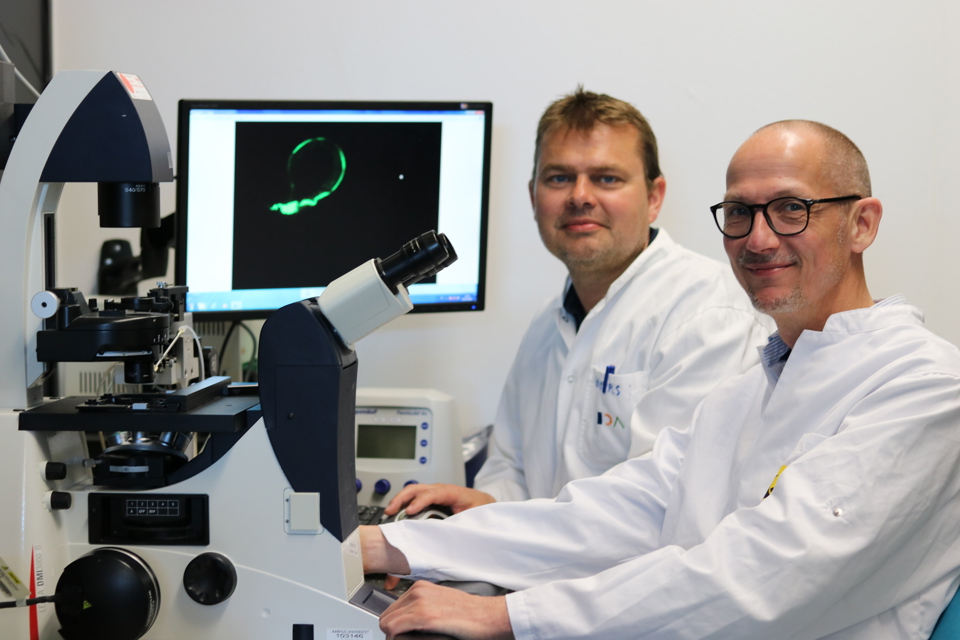From single antibody to effective treatment
It is of course a long process from the day the researchers identify antibodies that work and until the day these antibodies can be used to treat patients – maybe as much as 10 years. And the researchers face a number of challenges along the way.
“Our bodies are capable of creating millions of different antibodies. In our DNA, we have genes that include the code for creating these antibodies, and we can isolate these genes and extract them so we can work with them in the lab. If, then, we have a pool of genes, we can create a pool of antibodies – proteins – but only one single one will work on the cancer cell. In addition, if we want to be able to treat and cure patients, we need a lot of this exact antibody, and the challenge is to identify which gene holds the code for it so we will be able to mass-produce it” Peter Kristensen explains.
This challenge is connected to what is known as the “central dogma” of molecular biology: You have DNA on the one hand and an antibody (a protein) on the other hand – and in between, a messenger called messengerRNA. You can identify the messengerRNA from the DNA, and you can identify the DNA from the messengerRNA – but once you take the next step from messengerRNA to the protein, you lose the ability to identify the process backwards. In other words: You cannot identify the gene from the protein.
- “What we do here is try to short circuit this dogma by creating a physical connection between a specific gene and the protein/antibody created by that gene. In order to do this, we use a virus called filamentous bacteriophages. In essence, a virus consists of DNA surrounded by a “shield”, called a capsid, consisting of proteins. The genes containing the code for these proteins are present in the DNA. If we then take a gene for an antibody and insert that into the virus DNA in connection with one of the capsid proteins, the DNA will start creating the antibody along with the capsid protein, and we end up with a virus particle with the antibody on its surface” Peter Kristensen explains. At this point, the researchers have both the antibody AND the DNA inside the virus particle that has created the antibody, in other words, a physical connection between the DNA and the antibody.
- “Once we have made this connection, we can start working with a million different virus particles, each with a specific antibody on its surface. Then we combine these virus particles with our slowly-dividing cancer cells, wash away all the virus particles that do not attach to the cells – and what we have left are virus particles that attach to the cancer cells because they have an antibody on their surface that recognises and attaches to the specific surface markers of that cancer cell” Peter Kristensen explains. “And most importantly: not only do we at this point have the effective antibody that latches on to the surface markers – we also have the gene that created that antibody. This means that we can start producing a lot of that antibody, and in combination with now also being able to identify the surface markers of non- or slowly-dividing cancer cells in thousands of patients, this means that we can create targeted, effective treatment that can hopefully cure them” he finishes.
Aiming for a healthier old age
While such work leads to some people seeing “old age” as just another disease that should be cured so we will be able to live forever, both researchers agree that this is not the case.
- “When talking about research in gerontology and age-related diseases, a significant point is that we do not see ageing as a disease that we are trying to cure. We work to understand how the ageing processes work, and we work to understand how diseases work and how we can cure them, but it is very important to make the distinction between our life span and our health span” Anders Olsen emphasises.
- “Some researchers believe that the mechanisms that lead to ageing are also the mechanisms that lead to some of the common diseases, and so if we can understand these processes and delay the ageing process, maybe we can delay or get rid of the diseases as well and be healthy for a longer time. And there is evidence to both support and deny that point – I believe that you can grow old without getting sick and weak, and we do see more and more people who parachute at the age of 80, for instance. To me, the aim of the work we do here is to enable people to grow old but still be active, healthy and independent” he finishes.
